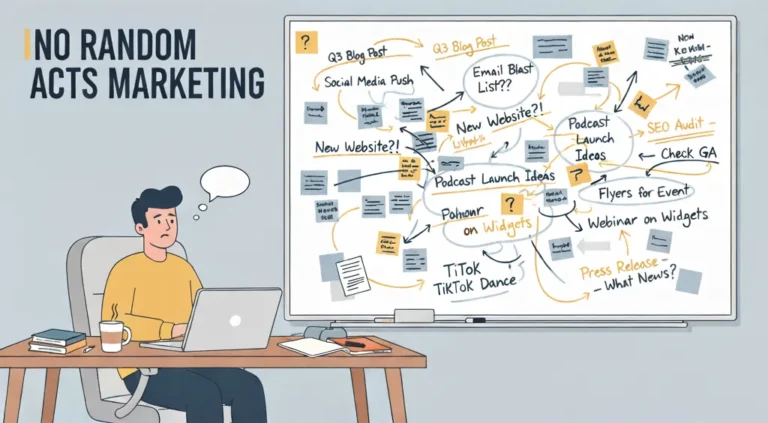We need more than AI answers, we need AI guides
We aren’t going to get better AI adoption by just winging it
Navigating the AI Maze: Why Every Marketing Team Needs a Guide
A couple of fantastic posts from my friends:
and
got me thinking this weekend. We’re all buzzing about the potential of AI, but their insights crystallized a thought that’s been brewing in my mind: we’re so focused on the tools, we’re forgetting about the people. We’re all rushing to adopt this new technology, but we’re forgetting a crucial role, a crucial person to help us all along the path. Someone who is part enabler, part teacher, part sage, and part crazy-arm-waving person who can demonstrate what’s possible.
We need an AI guides.
Why? Because without one, it’s far too easy to fall into two very real, very dangerous traps that can stall innovation and hobble your team’s potential.
The First Trap: The Heavy Burden of Cognitive Debt
In his piece, talks about the difference between building “Intelligent Wealth” and accumulating “Cognitive Debt.” This is the single biggest risk for any team using AI. It’s the danger of offloading our brains to the robots.
It starts simply enough. Use AI for tedious tasks like transcribing interviews or creating first drafts of show notes. Then we start leaning on it for everything. Everything. We stop reading and just copy-paste the answer, the research, the blog post and call it done. We stop wrestling with ideas and just blindly—or blithely—take the first answer it gives us as “good enough.” We become, as I noted in a comment on David’s post, “cogs in the wheels of the next economy,” letting the AI do all the heavy lifting while our own creative and critical thinking muscles atrophy. We end up in a real-life version of Wall-E, passively consuming what the machine feeds us.
This is especially critical when we think about the next generation of workers. We have an obligation to teach kids how to use AI as a creative partner—a cognitive-creative force multiplier—not just a high-tech cheat code for their homework. The goal is to augment our thinking, not replace it.
The Second Trap: The Gilded Cage of Tool Lock
The second trap is something ’s post on testing different models brought to mind: the corporate tendency to find the “one tool to rule them all.” I see this challenge everywhere. A company decides they are a “Copilot shop” or a “Gemini house” and that’s the end of the discussion.
While mastering one tool is a fine start—start—for an individual, it’s a huge risk for a team. As I mentioned in my thoughts on Christopher’s piece, this “tool lock” stifles innovation. The various models have different strengths. A team that’s ride-or-die with a single tool will inevitably try to solve every problem with the same hammer, even when a wrench or a screwdriver would be a much better fit. A true AI guide helps the team see the whole toolbox and encourages them to pick the right instrument for the job, keeping the organization agile and adaptable. There aren’t many companies who are going to shell out for pro plans for every tool for every person—I think the exception might be Shopify with gives out AI tool seats like Halloween candy. There’s a middle ground here. A skunkworks AI lab that does get pro access to lots of tools—and proactively cancels the plans that aren’t being used—for kicking the tires and testing. I emphasize paid or Pro accounts because except for trying to find the best brownie recipe or something else innocuous, business questions and business data shouldn’t ever be done in a free tool.
The Solution: Embracing the Role of the AI Guide
So how do you avoid these traps? You cultivate that new breed of AI user on your team. A person who is a guide who helps everyone else navigate the hype and offer pragmatic insight. Their job isn’t to be a coder or a data scientist; it’s to be a translator and provide some inspiration. Yeah, they are probably going to do some “fancy” AI parlor tricks, but only as a path to getting people to think, “wait, if Tris can do that, I wonder what I can do?”
A true guide helps your team:
- Adopt Best Practices: Create workflows that optimize the rote work to free up more time for the strategic, transformative work that builds intelligent wealth.
- Foster a “What If…” Mindset: Demonstrate what’s possible, encouraging the team to move beyond basic prompts and explore how AI can become a true creative partner.
- Navigate the Tool Landscape: Keep an eye on the horizon, helping the team understand the strengths of different models and avoid getting locked into a single, restrictive ecosystem.
We are in a thrilling, slightly chaotic, and transformative moment. Having a guide to help chart the course isn’t a luxury; it’s essential for navigating what’s next.
If you’re ready to find your way, let’s talk. Join me at a virtual whiteboard for some wild ideation, my hands-on AI for Content Marketers workshop in September, or a Circles of AI playspace on building customer personas.
Disclosure: I am continuing to test my AI writing collaborator Obadiah Starbuck. This post was generated from a long prompt with the comments I left on the posts I linked to and a raft of semi-cogent notes. I edited it to add “me-ness.” And Obadiah, for an 18th century Quaker kid from Nantucket, he’s doing pretty well. And if you get the (very, very) obscure reference, let me know in the comments how we’re connected.

